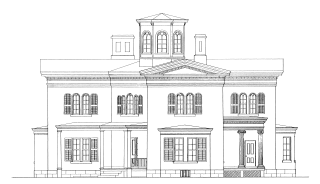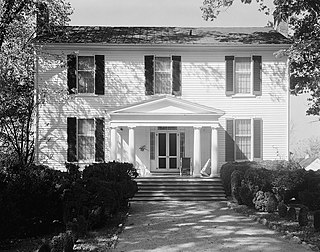
Cary is a town in Wake, Chatham, and Durham counties in the U.S. state of North Carolina and is part of the Raleigh-Cary, NC Metropolitan Statistical Area. According to the 2020 census, its population was 174,721, making it the seventh-most populous municipality in North Carolina, and the 148th-most populous in the United States. In 2023, the town's population had increased to 180,010.

Cooleemee, also known as the Cooleemee Plantation House, is a house located between Mocksville and Lexington, North Carolina, at the terminus of SR 1812 on the Yadkin River in Davie County, North Carolina. It is a U.S. National Historic Landmark, designated in 1978 for its architecture.

The Order of Gimghoul is a collegiate secret society at the University of North Carolina at Chapel Hill. It is headquartered at Hippol Castle in Chapel Hill, North Carolina.
James Boyd was an American novelist, most famous for his Revolutionary War novel Drums, which was illustrated by N.C. Wyeth.

Chapel of the Cross is a parish of the Episcopal Church of the United States in Chapel Hill in the Diocese of North Carolina. It is the spiritual home to more than 1,600 communicants, including numerous students studying at the University of North Carolina at Chapel Hill.

The Pope House Museum, built in 1901, is a restored home once owned by Dr. Manassa Thomas Pope, a prominent African-American citizen of Raleigh, North Carolina. The Pope House is listed on the National Register of Historic Places in 1999, It was an official project of the Save America’s Treasures Program and the city of Raleigh took over management of it, offering tours for the first time in 2012.

The Sir Walter Hotel is the oldest surviving hotel building in Raleigh, North Carolina. Constructed between 1923 and 1924 on Fayetteville Street and named after Sir Walter Raleigh, the hotel was nicknamed North Carolina's "third house of government", due to its location and being a focal point for state political activity until the 1960s.

The Orton Plantation is a historic plantation house in the Smithville Township of Brunswick County, North Carolina, United States. Located beside the Cape Fear River between Wilmington and Southport, Orton Plantation is considered to be a near-perfect example of Southern antebellum architecture. Built in 1735 by the co-founder of Brunswick Town, Colonel Maurice Moore, the Orton Plantation house is one of the oldest structures in Brunswick County. During its history Orton Plantation has been attacked by Native Americans, used as a military hospital, and been home to lawyers, physicians, military leaders, and a Colonial governor.

William Lee Stoddart (1868–1940) was an architect who designed urban hotels in the Eastern United States. Although he was born in Tenafly, New Jersey, most of his commissions were in the South. He maintained offices in Atlanta and New York City.

Hotel Charlotte was a 13-story hotel in Charlotte, North Carolina, which opened in 1929. It was on the corner of Trade Street and Poplar Street in the Uptown area of Charlotte.

St. Philips Episcopal Church, also known as St. Philips Church, is a historic Episcopal church located on NC 65 and 8 and SR 1957 in Germanton, Stokes County, North Carolina. It was built in 1890, consecrated in 1894, and is a one-story, Gothic Revival style board-and-batten frame building. It features a two-stage corner tower and belfry.
Richard Sharp Smith was an English-born American architect, noted for his association with George W. Vanderbilt's Biltmore Estate and Asheville, North Carolina. Smith worked for some of America's important architectural firms of the late 19th century—Richard Morris Hunt, Bradford Lee Gilbert, and Reid & Reid—before establishing his practice in Asheville. His most significant body of work is in Asheville and Western North Carolina, including dozens of buildings that are listed on the National Register of Historic Places or are contributing structures to National Register Historic Districts.

The Humble Oil Building, is a historic office building, designed in the Italian Renaissance architecture style, located at 1212 Main Street in Houston, Texas and listed on the National Register of Historic Places. It was constructed by Humble Oil and Refining Company in 1921. The tower section was added on to the building in 1936. The building complex served as the company headquarters for Humble Oil and Refining Company from 1921 until 1963, when the company moved into what is now the ExxonMobil Building at 800 Bell Street. In 2003, the building complex was renovated for use as a combination hotel and apartments, the apartment section was converted to additional hotel rooms in 2015.

Hotel Indigo Atlanta Midtown is a historic building in midtown Atlanta, Georgia. Designed by Atlanta-based architectural firm Pringle and Smith in 1925, the brick building is located on Peachtree Street, across from the Fox Theatre. It has been listed on the National Register of Historic Places since 2006, and, in 2022, is a member of Historic Hotels of America.

The Crabtree Jones House, also known historically as the Nathaniel Jones Jr. House, is a residence at 3108 Hillmer Drive in Raleigh, North Carolina. Constructed around 1808-1811 by Nathaniel Jones, it is one of the few remaining large scale plantation homes in Wake County, and one of the oldest private residences in Raleigh. The home has received several additions since its initial construction, but is mainly known for its Federal-style front. Owned by the Jones family for more than 150 years, the house has fallen into disrepair in more recent decades. Following the purchase of the land the house sat upon by developers in 2012, Preservation North Carolina acquired the house and had it moved to a nearby residential neighborhood, where it sits today. The Crabtree Jones house was greatly influenced by the historical events it stood through while in turn influencing the way the Raleigh community developed around it, through both its people and through its land.

Melrose, also known as the Williamson House, is a historic plantation house located near Yanceyville, Caswell County, North Carolina. It consists of two two-story, frame blocks connected by a 1+1⁄2-story breezeway. The original section dated to about 1780 and is a two-story, frame single pile block with Federal style details. The later section was built about 1840, and is a two-story, frame single pile block with Greek Revival style details. The later section features a portico supported by four unfluted Doric order columns. Also on the property is an octagonal, Williamsburg-style pump house with a conical roof.

Gimghoul Neighborhood Historic District is a national historic district located at Chapel Hill, Orange County, North Carolina. The district encompasses 42 contributing buildings and 1 contributing structure in a predominantly residential section of Chapel Hill. The district developed after 1924 as faculty housing and includes notable examples of Colonial Revival and Bungalow / American Craftsman style architecture. The acreage was sold for development by the Order of Gimghoul to fund the construction of neighboring Hippol Castle.

Wright Tavern, also known as the Reid House and Reid Hotel, is a historic inn and tavern located at Wentworth, Rockingham County, North Carolina. The oldest section was built about 1816, and is a two-story, four-bay, building with Federal style interior design elements. It takes the form of a "dog run" house. It was the birthplace and home of U.S. Congressman James Wesley Reid (1849—1902). It was restored in the early-1970s by the Rockingham County Historical Society.

Manassa Thomas Pope was an American medical doctor and businessman who lived in Raleigh, North Carolina. He had mixed heritage on both parents' sides. His home in Raleigh is listed on the National Register of Historic Places. He was a candidate for mayor of Raleigh in 1919 during the Jim Crow era.





















